Kanji Tanaka
MOON: Multi-Objective Optimization-Driven Object-Goal Navigation Using a Variable-Horizon Set-Orienteering Planner
May 19, 2025Abstract:Object-goal navigation (ON) enables autonomous robots to locate and reach user-specified objects in previously unknown environments, offering promising applications in domains such as assistive care and disaster response. Existing ON methods -- including training-free approaches, reinforcement learning, and zero-shot planners -- generally depend on active exploration to identify landmark objects (e.g., kitchens or desks), followed by navigation toward semantically related targets (e.g., a specific mug). However, these methods often lack strategic planning and do not adequately address trade-offs among multiple objectives. To overcome these challenges, we propose a novel framework that formulates ON as a multi-objective optimization problem (MOO), balancing frontier-based knowledge exploration with knowledge exploitation over previously observed landmarks; we call this framework MOON (MOO-driven ON). We implement a prototype MOON system that integrates three key components: (1) building on QOM [IROS05], a classical ON system that compactly and discriminatively encodes landmarks based on their semantic relevance to the target; (2) integrating StructNav [RSS23], a recently proposed training-free planner, to enhance the navigation pipeline; and (3) introducing a variable-horizon set orienteering problem formulation to enable global optimization over both exploration and exploitation strategies. This work represents an important first step toward developing globally optimized, next-generation object-goal navigation systems.
LGR: LLM-Guided Ranking of Frontiers for Object Goal Navigation
Mar 26, 2025Abstract:Object Goal Navigation (OGN) is a fundamental task for robots and AI, with key applications such as mobile robot image databases (MRID). In particular, mapless OGN is essential in scenarios involving unknown or dynamic environments. This study aims to enhance recent modular mapless OGN systems by leveraging the commonsense reasoning capabilities of large language models (LLMs). Specifically, we address the challenge of determining the visiting order in frontier-based exploration by framing it as a frontier ranking problem. Our approach is grounded in recent findings that, while LLMs cannot determine the absolute value of a frontier, they excel at evaluating the relative value between multiple frontiers viewed within a single image using the view image as context. We dynamically manage the frontier list by adding and removing elements, using an LLM as a ranking model. The ranking results are represented as reciprocal rank vectors, which are ideal for multi-view, multi-query information fusion. We validate the effectiveness of our method through evaluations in Habitat-Sim.
Dynamic-Dark SLAM: RGB-Thermal Cooperative Robot Vision Strategy for Multi-Person Tracking in Both Well-Lit and Low-Light Scenes
Mar 17, 2025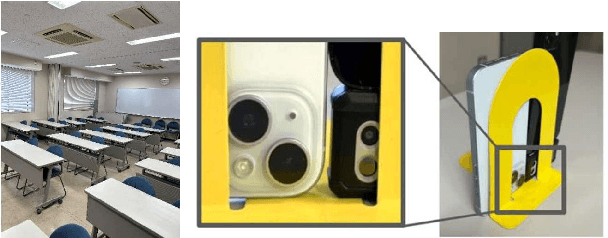
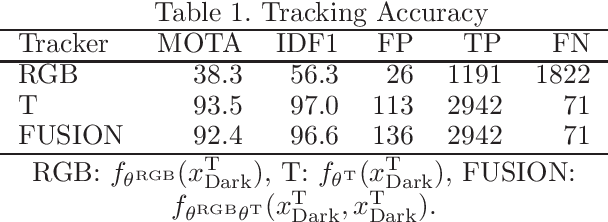
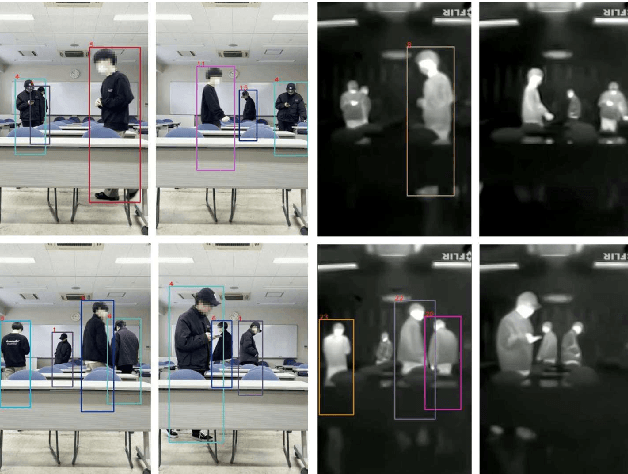

Abstract:In robot vision, thermal cameras have significant potential for recognizing humans even in complete darkness. However, their application to multi-person tracking (MPT) has lagged due to data scarcity and difficulties in individual identification. In this study, we propose a cooperative MPT system that utilizes co-located RGB and thermal cameras, using pseudo-annotations (bounding boxes + person IDs) to train RGB and T trackers. Evaluation experiments demonstrate that the T tracker achieves remarkable performance in both bright and dark scenes. Furthermore, results suggest that a tracker-switching approach using a binary brightness classifier is more suitable than a tracker-fusion approach for information integration. This study marks a crucial first step toward ``Dynamic-Dark SLAM," enabling effective recognition, understanding, and reconstruction of individuals, occluding objects, and traversable areas in dynamic environments, both bright and dark.
Continual Multi-Robot Learning from Black-Box Visual Place Recognition Models
Mar 04, 2025
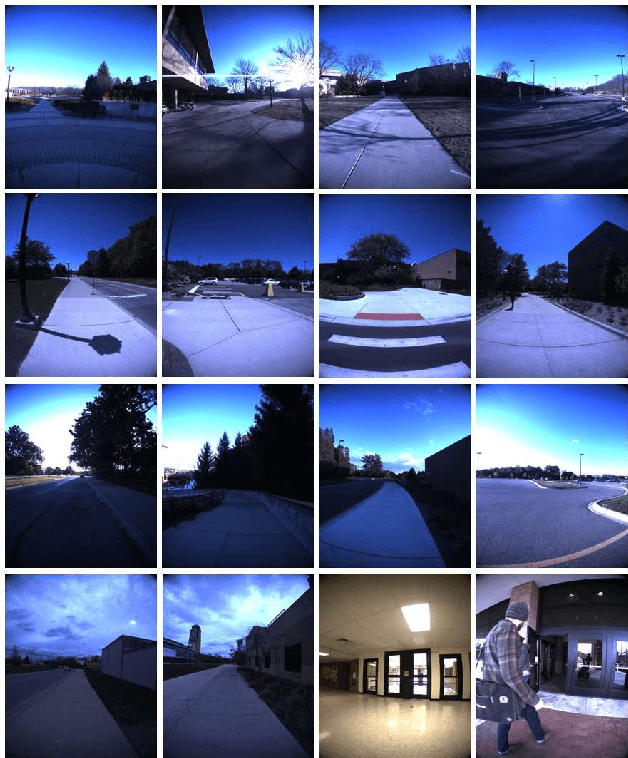
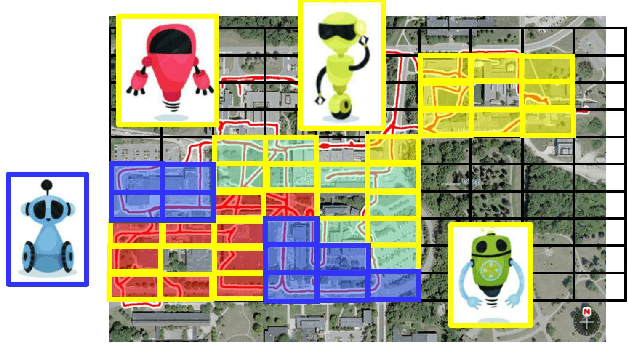
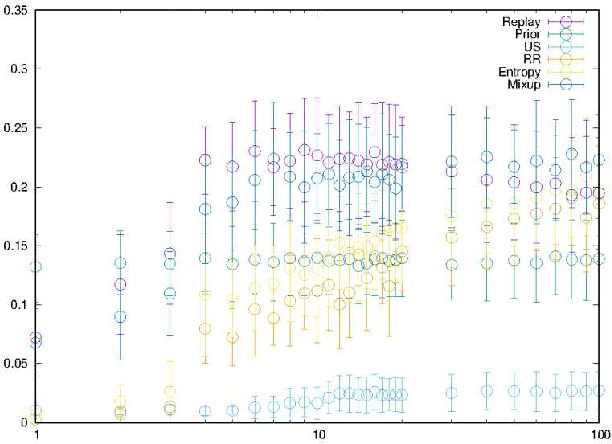
Abstract:In the context of visual place recognition (VPR), continual learning (CL) techniques offer significant potential for avoiding catastrophic forgetting when learning new places. However, existing CL methods often focus on knowledge transfer from a known model to a new one, overlooking the existence of unknown black-box models. We explore a novel multi-robot CL approach that enables knowledge transfer from black-box VPR models (teachers), such as those of local robots encountered by traveler robots (students) in unknown environments. Specifically, we introduce Membership Inference Attack, or MIA, the only major privacy attack applicable to black-box models, and leverage it to reconstruct pseudo training sets, which serve as the key knowledge to be exchanged between robots, from black-box VPR models. Furthermore, we aim to overcome the inherently low sampling efficiency of MIA by leveraging insights on place class prediction distribution and un-learned class detection imported from the VPR literature as a prior distribution. We also analyze both the individual effects of these methods and their combined impact. Experimental results demonstrate that our black-box MIA (BB-MIA) approach is remarkably powerful despite its simplicity, significantly enhancing the VPR capability of lower-performing robots through brief communication with other robots. This study contributes to optimizing knowledge sharing between robots in VPR and enhancing autonomy in open-world environments with multi-robot systems that are fault-tolerant and scalable.
LMD-PGN: Cross-Modal Knowledge Distillation from First-Person-View Images to Third-Person-View BEV Maps for Universal Point Goal Navigation
Dec 23, 2024Abstract:Point goal navigation (PGN) is a mapless navigation approach that trains robots to visually navigate to goal points without relying on pre-built maps. Despite significant progress in handling complex environments using deep reinforcement learning, current PGN methods are designed for single-robot systems, limiting their generalizability to multi-robot scenarios with diverse platforms. This paper addresses this limitation by proposing a knowledge transfer framework for PGN, allowing a teacher robot to transfer its learned navigation model to student robots, including those with unknown or black-box platforms. We introduce a novel knowledge distillation (KD) framework that transfers first-person-view (FPV) representations (view images, turning/forward actions) to universally applicable third-person-view (TPV) representations (local maps, subgoals). The state is redefined as reconstructed local maps using SLAM, while actions are mapped to subgoals on a predefined grid. To enhance training efficiency, we propose a sampling-efficient KD approach that aligns training episodes via a noise-robust local map descriptor (LMD). Although validated on 2D wheeled robots, this method can be extended to 3D action spaces, such as drones. Experiments conducted in Habitat-Sim demonstrate the feasibility of the proposed framework, requiring minimal implementation effort. This study highlights the potential for scalable and cross-platform PGN solutions, expanding the applicability of embodied AI systems in multi-robot scenarios.
ON as ALC: Active Loop Closing Object Goal Navigation
Dec 16, 2024Abstract:In simultaneous localization and mapping, active loop closing (ALC) is an active vision problem that aims to visually guide a robot to maximize the chances of revisiting previously visited points, thereby resetting the drift errors accumulated in the incrementally built map during travel. However, current mainstream navigation strategies that leverage such incomplete maps as workspace prior knowledge often fail in modern long-term autonomy long-distance travel scenarios where map accumulation errors become significant. To address these limitations of map-based navigation, this paper is the first to explore mapless navigation in the embodied AI field, in particular, to utilize object-goal navigation (commonly abbreviated as ON, ObjNav, or OGN) techniques that efficiently explore target objects without using such a prior map. Specifically, in this work, we start from an off-the-shelf mapless ON planner, extend it to utilize a prior map, and further show that the performance in long-distance ALC (LD-ALC) can be maximized by minimizing ``ALC loss" and ``ON loss". This study highlights a simple and effective approach, called ALC-ON (ALCON), to accelerate the progress of challenging long-distance ALC technology by leveraging the growing frontier-guided, data-driven, and LLM-guided ON technologies.
DRIP: Discriminative Rotation-Invariant Pole Landmark Descriptor for 3D LiDAR Localization
Jun 17, 2024Abstract:In 3D LiDAR-based robot self-localization, pole-like landmarks are gaining popularity as lightweight and discriminative landmarks. This work introduces a novel approach called "discriminative rotation-invariant poles," which enhances the discriminability of pole-like landmarks while maintaining their lightweight nature. Unlike conventional methods that model a pole landmark as a 3D line segment perpendicular to the ground, we propose a simple yet powerful approach that includes not only the line segment's main body but also its surrounding local region of interest (ROI) as part of the pole landmark. Specifically, we describe the appearance, geometry, and semantic features within this ROI to improve the discriminability of the pole landmark. Since such pole landmarks are no longer rotation-invariant, we introduce a novel rotation-invariant convolutional neural network that automatically and efficiently extracts rotation-invariant features from input point clouds for recognition. Furthermore, we train a pole dictionary through unsupervised learning and use it to compress poles into compact pole words, thereby significantly reducing real-time costs while maintaining optimal self-localization performance. Monte Carlo localization experiments using publicly available NCLT dataset demonstrate that the proposed method improves a state-of-the-art pole-based localization framework.
Zero-shot Degree of Ill-posedness Estimation for Active Small Object Change Detection
May 10, 2024Abstract:In everyday indoor navigation, robots often needto detect non-distinctive small-change objects (e.g., stationery,lost items, and junk, etc.) to maintain domain knowledge. Thisis most relevant to ground-view change detection (GVCD), a recently emerging research area in the field of computer vision.However, these existing techniques rely on high-quality class-specific object priors to regularize a change detector modelthat cannot be applied to semantically nondistinctive smallobjects. To address ill-posedness, in this study, we explorethe concept of degree-of-ill-posedness (DoI) from the newperspective of GVCD, aiming to improve both passive and activevision. This novel DoI problem is highly domain-dependent,and manually collecting fine-grained annotated training datais expensive. To regularize this problem, we apply the conceptof self-supervised learning to achieve efficient DoI estimationscheme and investigate its generalization to diverse datasets.Specifically, we tackle the challenging issue of obtaining self-supervision cues for semantically non-distinctive unseen smallobjects and show that novel "oversegmentation cues" from openvocabulary semantic segmentation can be effectively exploited.When applied to diverse real datasets, the proposed DoI modelcan boost state-of-the-art change detection models, and it showsstable and consistent improvements when evaluated on real-world datasets.
Training Self-localization Models for Unseen Unfamiliar Places via Teacher-to-Student Data-Free Knowledge Transfer
Mar 13, 2024


Abstract:A typical assumption in state-of-the-art self-localization models is that an annotated training dataset is available in the target workspace. However, this does not always hold when a robot travels in a general open-world. This study introduces a novel training scheme for open-world distributed robot systems. In our scheme, a robot ("student") can ask the other robots it meets at unfamiliar places ("teachers") for guidance. Specifically, a pseudo-training dataset is reconstructed from the teacher model and thereafter used for continual learning of the student model. Unlike typical knowledge transfer schemes, our scheme introduces only minimal assumptions on the teacher model, such that it can handle various types of open-set teachers, including uncooperative, untrainable (e.g., image retrieval engines), and blackbox teachers (i.e., data privacy). Rather than relying on the availability of private data of teachers as in existing methods, we propose to exploit an assumption that holds universally in self-localization tasks: "The teacher model is a self-localization system" and to reuse the self-localization system of a teacher as a sole accessible communication channel. We particularly focus on designing an excellent student/questioner whose interactions with teachers can yield effective question-and-answer sequences that can be used as pseudo-training datasets for the student self-localization model. When applied to a generic recursive knowledge distillation scenario, our approach exhibited stable and consistent performance improvement.
Recursive Distillation for Open-Set Distributed Robot Localization
Dec 26, 2023Abstract:A typical assumption in state-of-the-art self-localization models is that an annotated training dataset is available for the target workspace. However, this is not necessarily true when a robot travels around the general open world. This work introduces a novel training scheme for open-world distributed robot systems. In our scheme, a robot (``student") can ask the other robots it meets at unfamiliar places (``teachers") for guidance. Specifically, a pseudo-training dataset is reconstructed from the teacher model and then used for continual learning of the student model under domain, class, and vocabulary incremental setup. Unlike typical knowledge transfer schemes, our scheme introduces only minimal assumptions on the teacher model, so that it can handle various types of open-set teachers, including those uncooperative, untrainable (e.g., image retrieval engines), or black-box teachers (i.e., data privacy). In this paper, we investigate a ranking function as an instance of such generic models, using a challenging data-free recursive distillation scenario, where a student once trained can recursively join the next-generation open teacher set.
 Add to Chrome
Add to Chrome Add to Firefox
Add to Firefox Add to Edge
Add to Edge